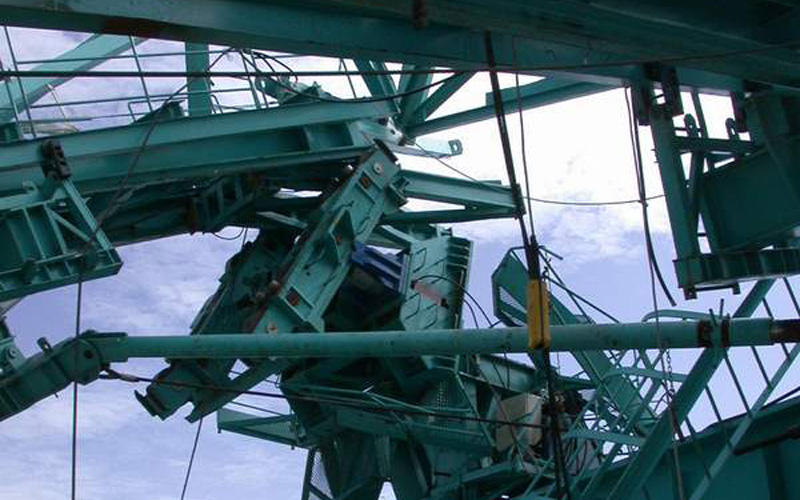Co-Editor of Bridge Deck Erection Equipment: A best practice guide, Max Meyer, examines the lessons that can be learnt from accidents with bridge deck erection equipment to minimise the occurrence of such events in the future.

- Updated: 17 Mar 2021
- Author: Max Meyer, Director, Rui-Feng International, Singapore
Use of Bridge Deck Erection Equipment (BDE) for the construction of bridge decks is widespread and enjoys ever growing popularity worldwide. It permits higher productivity, faster construction, makes it easier to achieve required quality of the permanent work and improves generally the overall safety of construction when compared with more conventional methods.
Sadly, accidents using BDE can still happen. These can result in serious injuries or even a loss of life. After an accident the BDE is almost always partially, if not completely, damaged which leads to considerable delays and overruns on the project.
The characteristics of a BDE
A BDE is not a crawler, mobile portal or tower crane, which are highly standardised and can be selected using supplier’s catalogues. A BDE is specially designed. It always requires kinematics, structural steel work features and other equipment components which are tailormade for the bridge deck it is going to build.
It is supported on and longitudinally fixed against the bridge it erects. This means, there are considerable interactions between the BDE and the permanent work. The BDE can have a bigger effect of the permanent work than its loading.
Another challenge arises because the BDE is subjected to various static systems during operation, each of which requires adequate longitudinal fixity and stability against overturning.
Furthermore, a BDE can’t be operated by a single person but needs a crew specifically trained in the operation of the BDE concerned. The design, fabrication, commissioning and subsequent operation of a BDE is not straightforward but rather complex. The key activities have to be carried out by specialists with track records and experience in BDE. The number of stake holders involved in the use of a BDE on a project is large: the owner, the permanent work consultant, the BDE designer, the construction engineering consultant, the checking engineer, the peer reviewer, the steel work fabricator, the equipment component supplier and the contractor.
Why do accidents happen with BDEs?
The management of all the interfaces between the above-mentioned stakeholders is complex. It requires an adequate contractual and organisational set up, not only at the contractor level but also at the owner’s level, which has to be based on the concept of ‘check & balance’. This is sometimes not understood and is, in fact, the root cause for most BDE accidents.
What can we learn from past accidents with BDE?
All stake holders involved in BDE need to have basic knowledge about the entire process when using a BDE on a project to fully appreciate the risk involved and understand what they can, and should, contribute to mitigate the risk of accidents.
A knowledgeable owner needs to ensure that not only the fabrication of a BDE is independently supervised by qualified inspection companies, but the design is independently checked by a structural consultant, and also peer reviewed by an individual, who is a real expert in BDE.
A knowledgeable owner should contractually require that the contractor demonstrates the BDE crews have been effectively trained and certified in its operation. Also, at all times only certified people should be operating the BDE. The site management of a BDE will always consist of a pilot (the superintendent) and the co-pilot (the gantry engineer).
A BDE supplier knowledgeable in the whole process (and not only in steel work fabrication and procurement of equipment components) welcomes the contractual requirement that the design of the BDE must be independently reviewed by a structural consultant and peer reviewed by a BDE expert. The technical information is, therefore, willingly shared about the equipment components with the checker and the peer reviewer.
A knowledgeable contractor employs people with experience in BDE to operate it or sublets the procurement and operation to a subcontractor specialised in BDE.
Introducing our book
A working group was formed some years back under the auspices of IABSE, with the task of publishing a best practice guide for the design, fabrication and operation of BDE.
The group, made up of experts in the subject matter from all over the world, recognised that to make the optimum use of BDE and also minimise occurrence of accidents, all stake holders involved in BDEs need basic but comprehensive knowledge about BDEs. This includes their types, kinematics, mechanisation, permanent work interfaces, management (procurement, fabrication, commissioning, operation), and risk and safety.
The book is written in four sections:
- Section 1 gives a classification of different bridge types and covers project management, and safety aspects of bridge construction.
- Section 2 discusses in detail the various types of BDE.
- Section 3 supplies important information about conceptual bridge design and detailing which should help bridge engineers to make their designs easier to build. It also covers BDE design, the mechanical and electrical components of BDE, precasting and lifting attachments.
- Section 4 gives recommendations for the industry which will hopefully contribute to an improvement in bridge design and construction.
Are you involved in BDE in any of the stake holder positions mentioned above? If yes, you can acquire or refresh your knowledge about all aspects of BDE through the working group’s book, Bridge Deck Erection Equipment – a best practice guide, available in both print and digital format.
